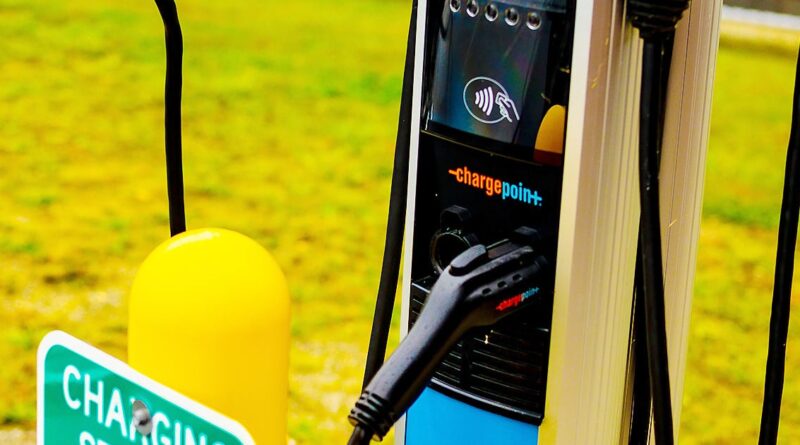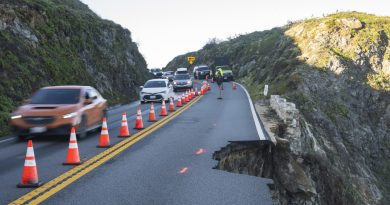Developing a nationwide charging network takes coordination across industries
More than half of new vehicles on the road could be electric within the next decade, but developing broad and reliable public charging infrastructure is like linking pieces of a broken puzzle. It’s a disjointed process that needs to be streamlined for drivers to be confident in finding a place to power up.
Charging network operators, utilities, automakers, retailers and oil companies that are investing in charging each have a role to play in the emerging landscape.
“How do you get all those people into the fold and contributing to a common goal?” said Brent Gruber, executive director of the EV practice at J.D. Power.
All the players are competing against the clock and say urgency is needed.
Automakers have aggressive rollout plans for EVs, consumer interest is rising, and the Biden administration is aiming for a 500,000-site charging infrastructure by 2030 — about a tenfold increase from today. Many forecasters expect EVs to make up more than half of new cars in the U.S. within the next decade because of the administration’s zero-emission goal and the EPA’s strictest-ever proposed vehicle emissions standards.
Automotive News spoke with more than two dozen industry stakeholders and observers to identify the hurdles to deploying charging infrastructure.
The U.S. has 62 networks run by charging companies, utilities, automakers and retail chains, according to Wood Mackenzie, an energy research and consultancy business.
“The market needs to be more streamlined to ensure a seamless EV charging experience, but we just don’t know which model works best yet,” said Amaiya Khardenavis, EV charging infrastructure analyst at Wood Mackenzie.
Building out public charging infrastructure is a time-consuming, complicated process that involves buy-in across industries. Scaling the infrastructure — a feat in itself — isn’t enough to establish consumer confidence, industry experts say. The hundreds of thousands of chargers that will be installed over the next several years must work for EV adoption to rise. Chargers today are largely unreliable, with 1 in 5 charging attempts in the U.S. failing last year, according to J.D. Power.
Gasoline companies — with a century-old business model — made the refueling process simple, standard and mostly reliable.
“We don’t have an equivalency here in EVs,” said Conrad Layson, senior alternative propulsion analyst at AutoForecast Solutions. “We haven’t made the experience simple enough to meet the average driver’s expectation of just being able to get in the damn car and drive.”
Instead, drivers traveling longer than a couple hundred miles must plan their route to incorporate a charging break of at least 20 minutes.
Once they stop for that break, there’s no guarantee the charger will work.
Charging satisfaction fell to a low in the third quarter of 2022, according to J.D. Power. Charging attempt failures were common among both Level 2 and DC fast chargers.
Fast chargers, which take about 20 minutes to restore power to 80 percent, are typically used when a driver is traveling long distances and the battery is depleted or won’t get the car to the destination. It’s often a planned charging stop.
Level 2 chargers, which take several hours to power a battery, are typically used at home or work or to top off during daily activities, such as shopping or dining at a restaurant. About two-thirds of charging sessions last year were done on a Level 2 charger, J.D. Power said.
No matter the charger type, charging companies “haven’t been held accountable and haven’t focused so much on reliability,” said Loren McDonald, CEO of EVAdoption. “It’s just, ‘We need the chargers. We need to get them in the ground.’ ”
Federal funding will likely encourage reliability improvements, analysts said. Charger ports must be functional 97 percent of the time to qualify for funding under the National Electric Vehicle Infrastructure Formula Program. The program also requires Tesla, widely known as having the most reliable network, to open part of its network to vehicles from other brands.
Executives at each of the three top charging companies — Electrify America, EVgo and ChargePoint — said the latest generation of chargers are more dependable than earlier iterations. The companies are prioritizing it, they said.
“The experience of yesterday is different from the experience of tomorrow,” said Bill Loewenthal, chief product officer at ChargePoint.
In January, EVgo launched EVgo ReNew, a program that replaces, upgrades and retires hundreds of chargers to improve reliability.
“In the early days, people were just grateful there was anything,” said Jonathan Levy, chief commercial officer at EVgo. “Now, especially as we’re into that mainstream [car buyer], it has to work. It has to be easy. It has to be convenient.”
The gas stations that drivers are accustomed to are convenient and generally functional. If one pump is defective, another nearby works.
But it isn’t an apples-to-apples comparison with charging stations in terms of scale because 85 percent of regular EV charging is done at home, according to J.D. Power estimates. Still, 1 in 3 consumers could not install a home charger if needed, the firm said. Most of those consumers live in multi-unit buildings or rent their homes.
Home charging has been easy for early EV adopters who have luxury vehicles and homes with private garages. As EVs become more affordable, the barriers to home charging will become more prominent, J.D. Power’s Gruber said.
Even with home charging as an option, the industry must make sure that public charging is available when and where drivers need it, analysts and charging company executives said.
There are about 2,000 internal combustion vehicles for every gas station in the U.S., according to EVAdoption. Charging station density looks better, with about 42 EVs for every site. But that’s not the whole story.
Charging gaps remain in much of the central and Western U.S. In EV-heavy California, there are more than 14,000 charging stations, while Montana, North Dakota, South Dakota, Wyoming and Mississippi each have fewer than 100 stations, according to Energy Department data.
There is confusion over the number of charging stations, as certain networks conflate individual charge ports and stations. Stations often have multiple ports. EVAdoption tallied 36,659 charging stations vs. the Department of Energy’s total of about 52,000. By EVAdoption’s calculation, there are 60 EVs for every charging station.
For long-distance travel, a 20-minute stop to charge requires a change in mindset by mass-market consumers conditioned to fueling in just minutes at gas stations.
“There needs to be an acknowledgment that the way in which people will dwell at these stations and the general time it takes is different,” said Graham Evans, director of the supply chain and technology group at S&P Global Mobility.
Charging company leaders believe consumers will adapt. But until consumers drive EVs, they won’t understand the fueling difference, said ChargePoint’s Loewenthal. When charging options are consistent and drivers get into the habit of parking and charging, EV adoption will increase, he said.
Consumers shouldn’t expect a gas station experience, he said. “The use model is way different. Typically, you’re seeing folks adopt EVs when they know they have a place to charge consistently.”
Companies that host charging sites — such as retailers, restaurants and travel centers — are critical for transforming the way drivers think about powering their vehicles on the road, he said.
They will have “amenities you’d want because you’ve got to fuel yourself as well as fuel the vehicle,” Loewenthal said.
But some industry observers are skeptical that consumers will adjust to a longer refill.
Battery and charging technology need to advance for faster charging, but until then, mass-market consumers are unlikely to change, said Mark Barrott, a principal in Plante Moran’s automotive practice.
“Current fueling speed has to be the baseline for what an EV mass-market driver will put up with,” he said.
Usually, a new technology or product must offer a tenfold improvement for consumers to change their behavior, said Kristin Slanina, mobility expert at Fast Future Fundamentals, a professional development company, and chief innovation officer for fleet logistics company ParkMyFleet.
“We’re not even close to that in terms of filling up your car versus charging your EV,” she said.
Charging networks and site hosts often must wait 18 months to two years to expand electricity capacity with new transformers and power lines. Many businesses withdraw their applications because of the long wait, said John Gartner, senior director of transparency and insights at the Center for Sustainable Energy. The center runs the California charging program and has disbursed $600 million in charger incentives for the state.
“There’s all these programs to incentivize charging infrastructure, but that won’t get them in the ground any faster because they’ve got to get sited and permitted, and capacity has to be there,” he said.
Electrify America canceled certain charger installations because obtaining adequate power supply would take two to three years, said Anthony Lambkin, vice president of operations for the company.
Electrify America has added battery storage systems to 150 charging sites to aid power supply.
The storage systems power the chargers that drivers plug into, and they recharge from the grid when drivers aren’t charging.
“We have deployed a megapack of batteries, over a megawatt-hour of storage, just to mitigate the effect of not having enough utility power [for] all of our chargers,” Lambkin said.
Charging companies are preparing for the future by adding battery storage systems, installing chargers that can support the high-power vehicle batteries that manufacturers are launching and deploying both Level 2 and fast chargers, though much recent focus has been on fast charging.
They need to keep up with an evolving market. There were several EVs or EV trims on sale in the U.S. in 2018, but more than 50 electric nameplates will be by the end of this year.
Charging infrastructure must continue to advance in order to develop a solid network by the time EVs scale.
The risk for now, J.D. Power’s Gruber said, is “taking the time to make sure that it’s being done right.”
Source : Autonews.com




